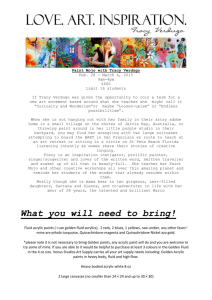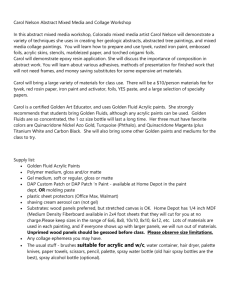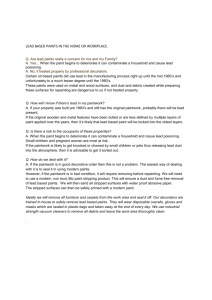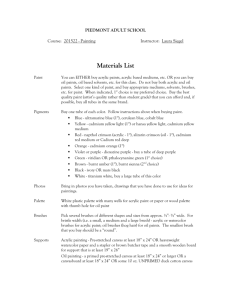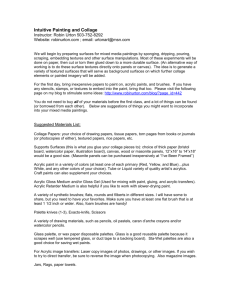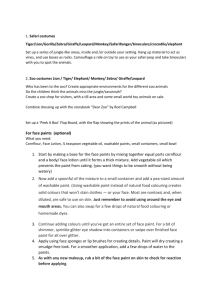Determining the Acceptable Ranges of Relative Humidity Marion F. Mecklenburg
advertisement
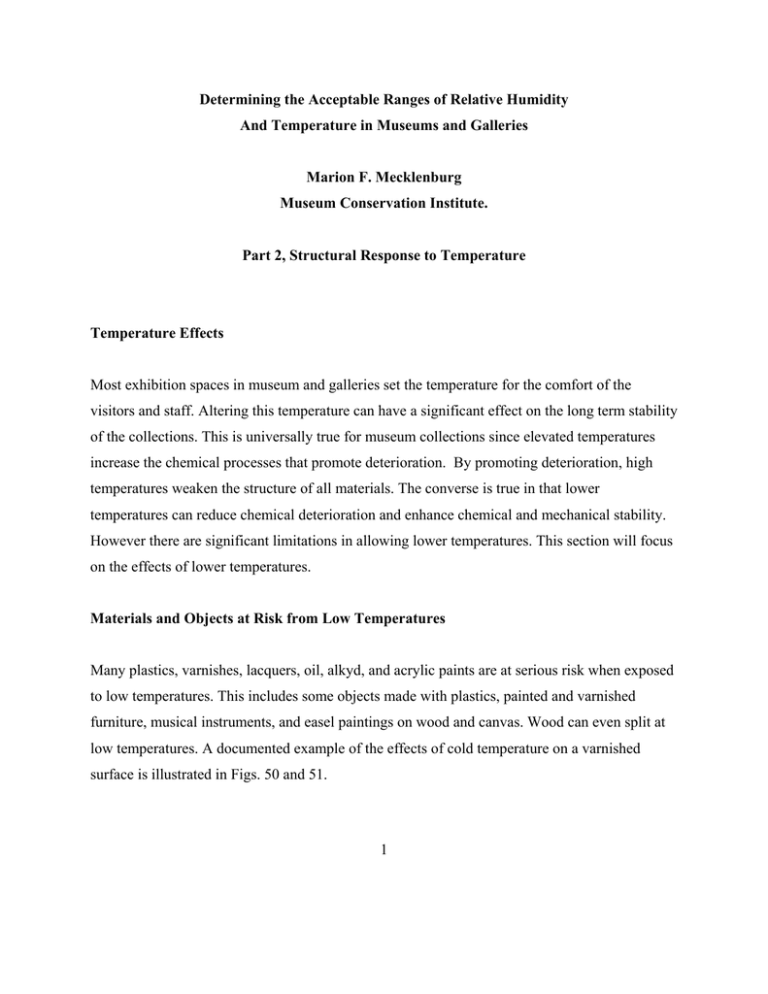
Determining the Acceptable Ranges of Relative Humidity And Temperature in Museums and Galleries Marion F. Mecklenburg Museum Conservation Institute. Part 2, Structural Response to Temperature Temperature Effects Most exhibition spaces in museum and galleries set the temperature for the comfort of the visitors and staff. Altering this temperature can have a significant effect on the long term stability of the collections. This is universally true for museum collections since elevated temperatures increase the chemical processes that promote deterioration. By promoting deterioration, high temperatures weaken the structure of all materials. The converse is true in that lower temperatures can reduce chemical deterioration and enhance chemical and mechanical stability. However there are significant limitations in allowing lower temperatures. This section will focus on the effects of lower temperatures. Materials and Objects at Risk from Low Temperatures Many plastics, varnishes, lacquers, oil, alkyd, and acrylic paints are at serious risk when exposed to low temperatures. This includes some objects made with plastics, painted and varnished furniture, musical instruments, and easel paintings on wood and canvas. Wood can even split at low temperatures. A documented example of the effects of cold temperature on a varnished surface is illustrated in Figs. 50 and 51. 1 These figures shows the cracked varnish coating on a classical guitar after being exposed to 5o F. Cracking from low temperature can happen as fast as it takes for the object to come to equilibrium with the new temperature. In both figures it is clear that the cracking of the varnish runs predominantly across the grain of the wood. This is because the wood moves little in the direction of the grain with changes in temperature and is this acting as a restraint to the varnish layer. This also means that the wood is contracting in the direction perpendicular to the grain of the wood releasing stresses and strains in the varnish. In the discussion on the effects of relative humidity, it was also shown that the wood provides directional restraint to the surface coating applied to it. Then how is it possible to distinguish the difference between temperature damage and relative humidity damage if the object in question is un-documented? Figure 50 shows the cracked varnish coating on a classical guitar after being exposed to 5o F. 2 Figure 51 shows the cracked varnish coating on a classical guitar after being exposed to 5o F. In order to distinguish the difference between temperature and RH damage it is necessary to return to an examination of the materials themselves. Some of the traditional materials that should be characterized with respect to low temperature effects are hide glue, wood, ivory and paints. Aside from their obvious chemical differences they demonstrate significant differences in their resistance to low temperature. This will be illustrated in the following discussion. The Linear Coefficients of Thermal Expansion for Different Materials In the previous discussions on the dimensional change with changes relative humidity, it is clear that different materials respond differently. Some of the materials such as wood, hide glue and 3 ivory can have strain changes as much as 0.03-0.04 (3% to 4% elongation) when subjected to large RH changes. Further it was shown that there can be significant differences in the swelling behavior in oil paints, depending on the pigment used. But the dimensional response to temperature of most materials is low and remarkably consistent from one material to another. Hide Glue and Gelatin Figure 52 shows the dimensional change with temperature for several glues and gelatins. The strain change between 90o F and -20o F is only about 0.005 (0.05% elongation). Also marked in the figure is the strain range of +/- 0.005 which indicates that it is impossible to attain yield or failure in either tension or compression within the range of temperature shown. Hide Glues and Gelatins 0.01 Free Swelling Strains 10 Yr. Hide Glue Sturgeon Glue 0.005 Porcine A Gelatin +/- 0.005 0 Bovine B Gelatin Food Gelatin -0.005 -0.01 -40 -20 0 20 40 60 Temperature, F 80 100 Figure 52 shows the change is strain with respect to temperature of several glues and gelatins. These are extremely small changes, especially when compared to the dimensional effects of moisture. As a result the stresses developed from changes in temperature (Fig. 53) are significantly lower than those developed by changes in relative humidity (Fig. 54). Figure 53 shows the tensile 4 stresses measured in a restrained sample of hide glue with decreasing and increasing temperature. The material is acting in a fully elastic behavior since the path of the plot is the same for both the cooling and reheating of the specimen. It is because of these low level and reversible temperature induced stresses that allows freezing (-20o F) of 20th century photographic materials as a preservation technique. This is not possible with oil, alkyd, and acrylic paints. Stress vs. Temperature for Hide Glue 300 Stress (psi) 250 200 150 100 50 0 10 20 30 40 50 Temperature (F) 60 70 80 Figures 53 shows the tensile stresses measured in a restrained sample of hide glue with decreasing and increasing temperature. The material is acting in a fully elastic behavior since the path of the plot is the same for both the cooling and reheating of the specimen. 5 Hide Glue 5000 Stress (PSI) 4000 3000 2000 1000 0 0 20 40 60 Relative Humidity (%) 80 100 Figure 54 shows the stress developed for restrained samples of hide glue when desiccated from different levels of relative humidity. These stresses are considerably higher than the stresses developed in this same material when restrained and cooled. Where the plots stop their linear paths and start bending over indicates that the material is undergoing plastic deformation. Woods In general the thermal coefficients of expansion for woods are very low. The Wood Handbook defines thermal coefficients of woods in the tangential and radial directions as functions of their density. (1983 Wood Handbook) The higher the density, the higher the thermal coefficients but even higher density woods don’t have thermal coefficients significantly higher than shown in Fig. 55. 6 Free Swelling Strains Average Thermal Coeficients for Pines 0.005 0.004 0.003 0.002 0.001 0 -0.001 -0.002 -0.003 -0.004 -0.005 -40 +/- 0.005 Tangential direction Radial direction Longitudinal direction -20 0 20 40 Temperature (F) 60 80 100 Figure 55 shows the change is strain with respect to temperature for soft woods such as pine. These are extremely small changes, especially when compared to the dimensional effects of moisture. Ivory Walrus tusk shows very small strain changes with changes in temperature as seen in Fig. 56. Walrus Tusk, Radial Direction Free Swelling Strains 0.01 0.005 +/- 0.005 0 -0.005 -0.01 -20 0 20 40 60 Temperature (F) 80 100 Figure 56 shows the change is strain with respect to temperature for walrus tusk. 7 In order for wood, ivory or hide glue to either plastically deform or break as a result of low temperature, they have to be fully restrained and have high existing stresses. If free to respond dimensionally they have no structural problems. Acrylic Emulsion, Alkyd and Oil Paints and the Glass Transition Temperature, Tg As with the glue and gelatin, the change in strains with respect to the change in temperature for acrylic emulsions, alkyds, and oil paints are quite small. Figure 57 shows the dimensional change of acrylic emulsion paints with respect to temperature. These changes are considerably smaller than caused by relative humidity (Fig. 58). At first glance, because of the low dimensional changes it appears that the acrylic paints can be subjected to low temperature successfully. However acrylic, alkyds and oil paints get extremely brittle with low temperatures. At low temperatures, the paints undergo a glass transition, Tg. Also shown in Fig. 57 is a change in the slopes of the strain versus temperature plots. This change usually identifies the beginning of a phase change in the material and for these paints it is the beginning of a transition from an extremely flexible paint to a very brittle paint. So brittle that the strains to failure can be less than 0.005 which has been our standard reference yield point. Figure 59 shows the stress strain test results at different temperatures and relative humidity levels for Liquitex burnt sienna acrylic emulsion paint. As the temperature decreases there is a significant loss of strain (elongation) to failure and an increase in strength of the paint. This is typical of all acrylic emulsion paints. 8 Liquitex Acrylic Emulsion Paints 0.01 Free Swelling Strains Titanium White Cadmium Yellow 0.005 Cerulean Blue 0 Ultramarine Blue Cadmium Red -0.005 Approx. Tg -0.01 -40 -20 0 20 40 60 Temperature, F 80 Burnt Sienna 100 Figure 57 shows the change is strain with respect to temperature of several acrylic emulsion paints. These are extremely small changes, especially when compared to the dimensional effects of moisture. 20 Year Old Liquitex Acrylic Emulsion Paints 0.03 Free Swelling Strains Cadmium Red 0.02 Burnt Sienna 0.01 Ultramarine 0 Titianium White -0.01 -0.02 -0.03 0 20 40 60 80 Relative Humidity (%) 9 100 Figure 58 shows the change is strain with respect to relative humidity of several acrylic emulsion paints. These changes are considerably larger than those caused by temperature changes as seen in Fig. 57. 10 Year Old Liquitex Burnt Sienna 6000 20F, 5%RH 5000 Stress (psi) 41F, 5%RH 4000 52F, 5%RH 52F, 5% RH 3000 74F, 5%RH 2000 74F, 5%RH 1000 0 74F, 43%RH 0 0.1 0.2 0.3 Strain 0.4 0.5 0.6 Figure 59 shows the stress strain test results for a 10 year old Liquitex burnt sienna acrylic emulsion paint. At room temperature and 43% RH the paint is quite flexible. If the relative humidity is dropped to 5% at room temperature the paint strengthens but still retains some ability to elongate. At 5% RH and 52o F the paint has begun to lose the ability to elongate. Figure 60 shows the expanded scale for stress strain test results for a 10 year old Liquitex burnt sienna acrylic emulsion paint. At room temperature and 43% RH the paint is quite flexible. If the relative humidity is dropped to 5% at 72o F the paint strengthens but still retains some ability to elongate. At 5% RH and 52o F the paint has nearly lost all ability to elongate. Recall that it was around 50o F where there was a change in the slope of the plot of the free swelling strains versus temperature (Fig. 57). 10 10 Year Old Liquitex Burnt Sienna 6000 41F, 5% RH Stress (psi) 5000 4000 20F, 5% RH 3000 52F, 5% RH 74F, 5% RH 2000 1000 0.005 74F, 43% RH 0 0 0.02 0.04 0.06 0.08 0.1 Strain Figure 60 shows the expanded scale for stress strain test results for a 10 year old Liquitex burnt sienna acrylic emulsion paint. This is typical for all acrylic emulsion paints. If the paints shown in Fig. 57 were restrained and the temperature changed from 75o F to 20o F there would be an increase in mechanical strains of about 0.003-0.004. This may seem as a very small change but if there were initial strains in the paint film as would almost always be the case for a stretched canvas paintings, then the mechanical strains could easily exceed 0.005-0.01. Figure 60 shows that the strains of 0.005-0.01 exceed the breaking strains of the acrylic paint at 20o F by a considerable amount. One has to assume that there is always going to be initial strain in any canvas supported painting and never let the temperature drop below the glass transition temperature. Figure 61 shows the change is strain with respect to temperature of several oil paints. All oil paints, regardless of the pigment used, have similar dimensional responses to temperature. Included in this figure is the dimensional response of copper as is found in copper supported oil paintings. By contracting with temperature decreases, copper relieves some of the stresses and strain in the oil paint layers. This is another reason that these paintings have survived in such good condition. 11 Figures 62-65 show the stress strain tests results for different oil and alkyd paint at different environments. In all cases it is low temperature that induces brittle behavior and not low relative humidity. Different Oil Paints 0.01 Free Swelling Strains 20 Yr FW 20Yr Tit Wt 0.005 20Yr Yel Oc 0 22Yr FW #2 22 Yr Tit Wt #2 -0.005 22 Yr Cer Blue -0.01 -40 -20 0 20 40 60 Temperature, F 80 100 Copper Figure 61 shows the change is strain with respect to temperature of several oil paints. These are extremely small changes, especially when compared to the dimensional effects of moisture. Included in this figure is the dimensional response of copper as is found in copper supported oil paintings. By contracting with temperature decreases, copper relieves some of the stresses and strain in the oil paint layers. 12 14.5 year old basic lead carbonate in cold pressed linseed oil 1200 46% RH, 14F Stress (psi) 1000 10% RH, 73.4F 800 48% RH, 73.4F 600 400 200 0.005 0 0 0.01 0.02 0.03 Strain 0.04 0.05 0.06 Figure 62 shows stress versus strain plots of lead carbonate paint made with cold pressed linseed oil. The tests were conducted at three different environments, 48% RH, 73.4o F; 10% RH, 73.4o F, and 46% RH, 14o F. While lower humidity did increase the stiffness and strength of the paint, it was the low temperature that caused the paint to become extremely brittle. The breaking strain of the paint is less than 0.005. 14.5 year old basic lead carbonate in alkali ref. linseed oil 2000 46% RH, 14 F Stress (psi) 1500 1000 10% RH, 73.4 F 500 48% RH, 73.4 F 0.005 0 0 0.01 0.02 0.03 Strain 0.04 0.05 0.06 Figure 63 shows the stress versus strain plots of lead carbonate paint made with alkali refined linseed oil. The tests were conducted at three different environments, 48% RH, 73.4o F; 10% RH, 73.4o F, and 46% RH, 14o F. While lower humidity only slightly increased the stiffness and 13 strength of the paint, it was the low temperature that caused the paint to become extremely brittle. 14.5 year old zinc oxide in cold pressed linseed 800 46% RH, 14 F 10% RH, 73.4 F Stress (psi) 600 48% RH, 73.4 F 400 Basic lead carbonate in CPLO, 48% RH, 73.4 F (14.25 years old) 200 0.005 0 0 0.01 0.02 0.03 Strain 0.04 0.05 0.06 Figure 64, the stress versus strain plots of zinc oxide paint made with cold pressed linseed oil. The tests were conducted at three different environments, 48% RH, 73.4o F; 10% RH, 73.4o F, and 46% RH, 14o F. The zinc oxide paint is so brittle that neither the lowering of the RH or the temperature made a significant difference in the mechanical properties of this paint. The stress versus strain results of the lead carbonate paint made with cold pressed linseed oil are shown for comparison purposes. It might be the case that the paint made with the zinc oxide represents the stiffest paints might get over time. Old paints may not be as strong, but certainly not much stiffer. The tensile tests for a typical artist’s alkyd paint are shown in Fig. 65. As with the acrylic and oil paints low temperature causes the paint to become extremely brittle. 14 20 Year Old Alizarin Crimson Alkyd Paint 2000 23 F, 5%RH Stress (psi) 1500 72.5 F, 5%RH 1000 72.5 F, 58%RH 500 0.005 0 0 0.005 0.01 0.015 Strain 0.02 0.025 Figure 65, the stress versus strain plots at different environments of alizarin crimson alkyd paint. The tests were conducted at three different environments, 58% RH, 72.5o F; 5% RH, 72.5o F, and 5% RH, 23o F. Paints are some of the materials that are most prone to low temperature damage because of the glass transition temperature. For acrylic paints, Tg ~ 50oF to 45oF, for alkyd paints; Tg ~ 40oF to 35oF, and oil paints Tg ~ 32oF to -14oF. It can be stated that a significant proportion of the cracking seen in oil paint was due to low temperature and not RH related influences. Special Problems with Oil Paints Containing Zinc Oxide In the l9th Century certain pigments such as zinc oxide were introduced into the mainstream of artists’ materials. This pigment found its way into the grounds of paintings. In the 20th Century, because of toxic concerns, the use of lead carbonate was diminished and titanium dioxide was introduced as a replacement white. The problem is that oil paints using titanium dioxide dry to extremely weak and somewhat brittle films as shown in Fig. 24. Manufacturers of artists’ materials introduced zinc oxide into the titanium paints to give them additional strength. Paints made with only zinc oxide not only became more available to the 15 artists but most of the lead white paints often contain zinc. All of these paints become extremely brittle in as little as three years of drying even under “ideal” museum conditions. In addition to the white paints, many of the light colors labeled “hues” contain zinc and they can become equally brittle. While paint containing combinations of lead and zinc or titanium and zinc are quite stable with respect to relative humidity, they suffer badly if deformed. Paints containing zinc also bond poorly to adjacent layers of paints and grounds in paintings. Since artists have been and are currently using paints containing zinc supplied by many of the worlds’ artists’ materials manufactures, this is a condition that should be expected in many paintings in the future. This will have importance to both the exhibition and conservation of fine arts. Figure 66 shows a detail of an abstract expressionist painting from 1959 by Henry Cliffe. The oil paints used in this painting contain lead and zinc. This painting was rolled and the damage was extensive. In addition to the severe cracking, there is extensive interlayer delaminating of the paint layer. 16 Figure 66 shows a detail of a painting by Henry Cliffe, painted in 1959. The paint shown in this detail is lead white with zinc in it. Note the severe cracking and inter layer cleavage. This is mechanical damage due to rolling and not to moisture or temperature effects. (Photograph courtesy of Richard Saltoun and taken by Steve Gayler) Recently there have been rumors that “oil paints don’t adhere well to acrylic gesso grounds.” In order to confirm this, a series of test samples were prepared in 1999. Figure 67 shows one of the results of this test program. The gesso layers (horizontal strips, 1 in. wide) were cast first and allowed to dry for one month. The oil paints (vertical overlaying strips) were then cast. In the case the oil paint, lead white containing zinc oxide, could be easily delaminated from the acrylic ground. The layers separated from each other cleanly. 17 Figure 67 shows the commercial acrylic ground “C” below and the commercial lead white oil paint (containing zinc) above. With very little effort, the oil paint could be delaminated from the acrylic ground. The layers separated from each other cleanly. Paints under Restraint and Cooling Some comments need to be made with regard to temperature effects. Because at low temperatures oil paints get stiff (high modulus) the stresses developed in restrained and cooled paints can get high. It is remarkably deceptive how stiff and brittle paints can become at low temperatures. Acrylic emulsion paints are so flexible at room temperature it is easy to dismiss any stiffening of these paints. Never-the-less at low temperatures they can induce higher stresses when restrained than when subjected to low levels of relative humidity. Figure 68 shows the tensile stresses measured in restrained samples of acrylic emulsion paints with decreasing and increasing temperature. There is a change in the slope of the plots below 50o 18 F where the range for the glass transition temperature begins. The material is acting in a fully elastic behavior since the path of the plot is the same for both the cooling and reheating of the specimen. This makes sense since the highest strain change possible in the range from 80o F to 20o F is less than 0.005 which is within the elastic range. It is the transition to a brittle material that represents the threat to the stability of the paint. These paints are just at the edge of complete failure. Acrylic Emulsion Paints, Restrained Tests, 5% RH 350 COBALT BLUE Stress (psi) 300 CADMIUM YEL. 250 IVORY BLACK 200 150 100 50 0 0 20 40 60 Temperature (F) 80 100 Figure 68 shows the tensile stresses measured in restrained samples of acrylic emulsion paint with decreasing and increasing temperature. There is a change in the slope of the plots below 50o F where the range for the glass transition temperature begins. The material is acting in a fully elastic behavior since the path of the plot is the same for both the cooling and reheating of the specimen. Figure 69 shows the tensile stresses measured in restrained samples of oil paint with decreasing relative humidity. The maximum stress measured at about 8% RH is only about 65 psi as compared to the 190 psi attained when the specimen is restrained and cooled from 75o F to 20o F (Fig. 70). 19 Figure 70 shows the tensile stresses measured in a restrained sample of oil paint with decreasing and increasing temperature. The material is acting in a fully elastic behavior since the path of the plot is the same for both the cooling and reheating of the specimen. Again the maximum strains induced from a temperature change from 75o F to 20o F is less than 0.005 which is well with in the elastic range. At this point it is important to note that materials like wood and hide glue do not get brittle at low temperature since the glass transition temperature is higher than room temperature. Cooling never causes a phase transition. (McCormick-Goodhart, 1996) Desiccation of Restrained Oil Paints, 75 F 100 13 Year old Lead White Stress (psi) 80 60 13 Year old Naples Yellow 40 20 0 0 20 40 60 Relative Humidity (%) 80 Figure 69 shows the tensile stresses measured in restrained samples of oil paint with decreasing relative humidity. The maximum stress measured at about 8% RH is only about 65 psi as compared to the 190 psi attained when the specimen is restrained and cooled from 75o F to 20o F (Fig. 70). 20 Stress vs. Temperature for Restrained Specimens 200 13 year old Naples yellow oil paint Stress (psi) 150 100 50 0 10 20 30 40 50 Temperature (F) 60 70 80 Figure 70 shows the tensile stresses measured in a restrained sample of oil paint with decreasing and increasing temperature. The material is acting in a fully elastic behavior since the path of the plot is the same for both the cooling and reheating of the specimen. The Effects of Low Temperature on Canvas Supported Paintings It would be useful if one could distinguish the difference between damage caused by exposure to low temperature and damage caused by changes in relative humidity. Computer models indicate and predict that in general, exposure to low temperature would cause far more severe cracking in paintings than severe changes in relative humidity. (Mecklenburg et al, 1994, Mecklenburg and Tumosa, 1991) As an illustration if one were to model a traditional painting (either numerically or experimentally) then excessive RH changes could cause cracking but it would be limited to the corners of the paintings. This is illustrated in Figures 43 and 44 above. In addition research on the paints themselves showed that RH and high moisture related damage was selective. This meant that some paints such as lead white in linseed oil was a very durable paint and was resistant to moisture related damage. Further it was shown earlier in this discussion that the paints made with the earth colors were weak and prone to damage due to moisture. But the most 21 telling was the detrimental effect high moisture levels have on the hide glue sizes. Paint literally separated from the canvas (Figs. 45-47). In contrast, research into artists’ materials has shown low temperature damage is not selective. All of the paints, oil, alkyds, and acrylics, irrespective of the pigments used will go brittle and crack if restrained and the temperature is depressed sufficiently enough. On the other hand it can be shown that the hide glue is not very susceptible to damage from low temperature. So if paintings, either on canvas or wood panels, are exposed to sufficiently low temperature, the cracking will be extensive and indiscriminant. In addition there should be no separation of the paint layer from the canvas or panel. Finally the crack patterns can be distinctive on uniformly stretched canvas paintings. Figure 71 shows the theoretical crack pattern generated from the stress analysis of a computer model of a traditional canvas supported oil painting when the temperature is lowered from 72o F to -4o F. This model shows that the cracks are uniform throughout the painting indicating that the stresses are fairly uniform in magnitude. The pattern itself is a result of the strain release caused by the stretcher. For example, the cracks in the center of the painting are vertical (as shown in this image) but more importantly running primarily parallel to the short direction of the painting. That there are no horizontal cracks (parallel to the long direction) means that the long stretcher bars on the sides (being longer and more flexible) have deflected (bowed inward) under the thermal loading and released the stresses and strains in the paint layers in the short direction. It is the geometry (shape) of the painting that helps govern the crack pattern developed. Figures 72 and 73 show traditional oil paintings where Figure 74 shows a painting where the design layer was a mixture of Bocour (solvent based acrylic) and oil paints. The delaminating of the white paint layer is a result of the presence of zinc oxide pigment which promotes poor interlayer bonding of the design layers. 22 Figure 71 shows the theoretical crack pattern generated from the stress analysis of a computer model of a traditional canvas supported oil painting when the temperature is lowered from 72o F to -4o F. (Mecklenburg et al, 1991, 1994) 23 Figure 72 shows the crack pattern generated from the exposure of this painting to low temperature. This is verified by the lack of discrimination of the cracks. All of the paints are affected regardless of the pigment used. Also, there is no flaking or loss of paint in this painting. Figure 73, George Parker, Untitled, (Lower Ausable Lake at Indian Head), American, 1911, 48in. x 35.5in., this painting shows the crack pattern generated from the exposure to a low 24 temperature. This is verified by the lack of discrimination of the cracks. All of the paints are affected regardless of the pigments used. Also there is no flaking or loss of paint in this painting. This is a vertically oriented landscape but the cracks pattern again reflects the geometry of the painting. (Photo by James Hamm and courtesy of the Adirondack Museum in Blue Mountain Lake, N.Y.) Figure 74, Anonymous, American, c. 1972. This illustration shows the crack pattern generated from the exposure to low temperature of a painting where the design layer was a mixture of Bocour (solvent based acrylic) and oil paints. The delaminating of the white paint layer is a result of the presence of zinc oxide pigment which promotes poor interlayer bonding of the design layers. (Photo by James Hamm and courtesy of the owner) The Effects of Existing Cracks As with the effects of relative humidity, cracks due to low temperature act as expansion joints and inhibit further cracking when objects are reintroduced into similar environmental changes. 25 There is one major exception, Relative humidity changes have limits in that the maximum an object can experience is 0% RH to 100% RH and back again. This is not true for temperature changes because the range of temperatures can be quite expansive. If an object experienced cracking from exposure to 20o F, it can expect further damage at 0o F. It is not impossible for exterior temperatures to reach extraordinary lows periodically. Commentary on the Effects of Temperature Deviation from temperature set points affects cultural materials in two fundamental ways. One is the potential for changing chemical processes and the other is the potential for inducing mechanical stresses and strains. In general it can be said that the temperature for exhibition and storage spaces is established for the purpose of human comfort. Serious temperature deviations in either heating or cooling can certainly have adverse effects on human comfort levels. But there are other considerations such as the exposure to outdoor environments when objects are transported to other locations. In the wintertime cold weather can be a very real threat. The central set point and range for temperature under the current SI guidelines is 70o F +/- 4o F. If temperatures are elevated above 74o F (and still be within the human comfort levels) the worst one can expect is a slight increase in chemical activity that promotes deterioration of everything in the collection. If the temperature drops below 66o F, the chemical stability of the collection is greatly enhanced within certain limits. The question is where are the lower temperature limits? The lower limits are actually set by an object’s ability to maintain mechanical stability at lower temperatures. From 74o F and down to about 55o F (Tg for acrylics) there should be no structural problems with any of the collections. This is in large part due to the low thermal expansion coefficients of expansion of most of the cultural materials. Problems begin is when materials are subjected to temperatures below the 26 glass transition temperature (Tg). Below the glass transition temperature, materials become extremely brittle and combined with stresses brought on by low temperatures objects crack. This includes many plastics, varnish coatings and all oil, alkyd, and acrylic paints. Figures 74 and 75 show some of the raw temperature data from the National Museum of the American Indian Cultural Resource Center (NMAI CRC) and the Freer Gallery. On these plots are the current Smithsonian guidelines and the cautionary and danger zones. Above 74o F is the cautionary zone because of enhanced chemical activity. Below the 55o F is marked the danger zone as the glass transition temperature for acrylic paints begins around 50o F. CRC, January 2007, Air Handling Unit 4 100 90 Temperature (F) Cautionary Zone 80 70 60 50 Danger Zone 40 0 100 200 300 400 500 600 700 800 Tim e (hours) Figure 75 shows the monitored temperature data (dark blue line) for the NMAI CRC, AHU 4 in January 2007. Shown on this plot are the current Smithsonian guidelines, 70o F +/- 4o F, inside the light blue lines. The cautionary zone is above the 74o F line because of enhanced chemical activity. Below the 55o F is the danger zone because further cooling approaches the glass transition temperature of acrylic emulsion paints. 27 Freer, January 2007, PT2 Temperature (F) 100 90 Cautionary Zone 80 70 60 50 Danger Zone 40 0 100 200 300 400 500 600 700 800 Tim e (Hours) Figure 76 shows the RH monitored temperature data (dark blue line) for the Freer Gallery 18, in January 2007. Shown on this plot are the current Smithsonian guidelines, 70o F +/- 4o F, inside the light blue lines. The cautionary zone is above the 74o F line because of enhanced chemical activity. Below the 55o F is the danger zone because further cooling approaches the glass transition temperature of acrylic emulsion paints. References 1987, Wood Handbook: Wood as an Engineering Material, United States Department of Agriculture, Forest Service, Agriculture Handbook 72, U.S. Government Printing Service, Washington, D.C., 3-25. 1996, McCormick-Goodhart, M.H., “The Allowable Temperature and Relative Humidity Range for the Safe Storage of Photographic Materials,” Journal of the Society of Archivists, Vol. 17, No. 1, 7-21. 28 1994, Mecklenburg, M. F., M. McCormick-Goodhart and C. S. Tumosa, "Investigation into the Deterioration of Paintings and Photographs Using Computerized Modeling of Stress Development", Journal of the American Institute for Conservation, Volume 33(2), 153-170). 1991, Mecklenburg, M.F. and Tumosa, C.S., “Mechanical Behavior of Paintings Subjected to Changes in Temperature and Relative Humidity,” Art in Transit, Studies in the Transport of Paintings, M.F. Mecklenburg, Ed. National Gallery of Art, Washington, D.C., 173-216. Please contact Dr. Marion F. Mecklenburg, for permission to use this material. 29


